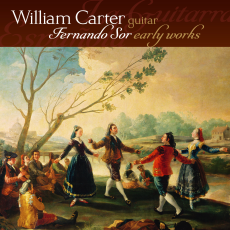Fernando Sor - William Carter - MusicWeb International
Apart from the immaculate recording and the stylishness and technical address of the playing - these features are outstanding in themselves - this release opens up another remarkable vista or aural sound picture. This concerns the use of the finger tip, not the nail, in playing the guitar. As William Carter's booklet note makes clear - it's quite a quixotic note, fun to read and elucidatory in many ways - playing exclusively with the nail is something that has happened only within the last century. Previously there was selective use of the nail and tip. Sor ‘was a tip player' and in a primer he wrote advised that ‘never in my life have I heard a guitarist whose playing was supportable if he played with the nails. The nails can produce but very few gradations in the quality of the sound...'
Now, Carter is not indulging in a polemic in this disc. He cites Sor's comments not to belittle other players - in fact, on the contrary, he is hugely generous to Segovia and Bream, whose recordings of Sor's music he knows intimately. His approach however honours Sor's own precepts and performance practices without prescribing others. I find his approach admirable, and admirably expressed.
The difference in character between these two approaches is palpable. Carter's use of Tony Johnson's 2006 guitar, which is patterned after nineteenth century models, and the use of the finger tip, imparts a wholly different sound to these works from one that we have become used to. It is more lyrical, it's softer, variegated, intimate, and less rhetorical than conventional performances.
In the cases of the Grand Solo Op.14 and the Menuet in G major one finds consistently that the suppler, salon orientation of the music is richly promoted by the use of the tip, avoiding the more metallic sense of projection of the nail. The character of the music is thereby subtly altered, and what can seem to be technical flourish in less sensitive hands is here played with a remarkable sense of affectionate plurality. The mellifluous, flowing lyricism of the A minor Op.11 Minuet is a delight, whilst the famous Op.9 Variations on a theme of Mozart is especially challenging, charming and persuasive evidence of the sense of colour that can be evoked by tip playing. He chooses well programmatically, contrasting the passionate expression of the Menuet in C minor, Op.24 No.1, with the more emollient charms of the salon-leaning elegance of the brief Menuet in C major, Op.5 No.3. I was especially struck by the pliancy of expression of the Andante Largo, Op.5 No.3 where control of its more stately elements co-exists with a refined colouristic palette. He plays a selection of the Studios for the Spanish Guitar, Op.6 and though these studies may seem didactic, they are in fact beautifully written examples of his art, not least No.8, a stretto study that is played with limpid grace. Even at his most demanding, as he is in the 12th study, Carter manages to disguise Sor's crippling difficulties through remarkable dexterity.
As far as one is aware this is the first such ‘tip' recording devoted wholly to Sor's works. I found it enchanting, gorgeously coloured, deeply musical and wholly convincing.

